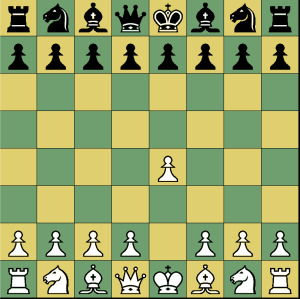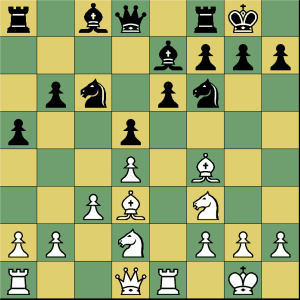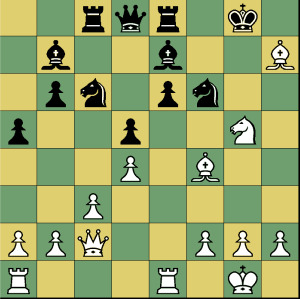Good Moves and Bad Moves
When you are reading a chess book, you will often find exclamation points or question marks (or some combination of exclamation points and question marks) after certain moves. These are generally accepted indications of good moves and bad moves. Here’s the normal meaning for these symbols:
- ? = bad move
- ?? = really bad or losing move
- ! = good move
- !! = brilliant move
- ?! = questionable move, probably bad
- !? = interesting move, possibly good
Ellipses …
When you see ellipses (the three dots …), that usually means that a move that was played is being omitted from the notation. It is most often used in a book or magazine before or after a diagram to indicate that it is Black’s move. For example, in the following diagram, it is Black’s move. This would be indicated in the following manner before the diagram:
1.e4 …

1… e5
The ellipses in the move before the diagram indicates that it is Black to move in the diagram. The ellipses after the diagram indicate that it is Black who has moved.
Other symbols
Some chess books (such as the Encyclopedia of Chess Openings) employ special symbols to indicate more detailed evaluations of positions in a single symbol. Many of those books are addressed to international readership and will usually have an explanation of the symbols somewhere in the book.
The moves for a complete game.
Here is an interesting game with a strong attack against the castled king and the sacrifice of a couple of pieces to maintain the attack. If you want to practice using chess notation, set up a chess board and play the moves listed below and check the position you get on your board against the diagrams shown below.
- e4 c6
- d4 d5
- exd5 cxd5
- Bd3 Nc6
- c3 Nf6
- Bf4 e6
- Nf3 Be7
- O-O a5
- Nbd2 O-O
- Re1 b6

- Ne5 Bb7
- Ndf3 Re8
- Qc2 g6?
- Nxf7! Kxf7
- Ng5+ Kg8
- Bxg6! Rc8??
- Bxh7+ Black resigns 1-0

If you’re practicing reading chess notation, compare the position above with the position you get on your chess board. After you’ve done that, try to work out why Black resigned. Black has four legal moves, and you should work out the best line for White after each possibility. (Don’t cheat … work out the answer. But then check your work with the answer posted in the comments. Look for Rj’s post and my response.)
If you’re interested in a great book for beginning chess players, check out Learn Chess: A Complete Course. I highly recommend it!

1) 17. Bxh7+ Kh8 18.Nf7+ Kg7 19. Qg6+ Kf8 20. Bh6 ++
2) 17. Bxh7+ Kh8 18.Nf7+ Kg7 19.Bh6+ Kxf7 20. Qg6++
3) 17. Bxh7+ Kf8 18. Nxe6+ Kf7 19. Qg6++
4) 17. Bxh7+ Kg7 18. Qg6+ Kf8 19. Nxe6++
5) 17. Bxh7+ Kg7 18. Qg6+ Kh8 19.Nf7++
6) 17.Bxh7+ Nxh7 18.Qxh7+ Kf8 19.Nxe6++
Really good, Rj! Your notation was perfect (note that checkmate is commonly designated by either ++ or #), and your analysis of the position was nearly perfect.
In your third line, you give 18.Nxe6+ and 19.Qg6 mate. But it’s not mate. Black still has 19…Kxe6. And though White has a winning attack, it will take some time to achieve the victory. The correct move is 18.Qg6, and White threatens mate three different ways: 19.Qf7#, 19.Qh6#, or 19.Nxe6#. Black can’t block them all.
In your fourth line, 19.Nxe6# is nice; there is also 19.Qf7#.
Your sixth line is correct. There is also 19.Qf7#. In addition, White could play 18.Qg6+, which leads to mate at either f7 or h7.
The rest of your analysis is correct and complete.
Thanks for posting the results of your work! 🙂
-Steve-
Opps. I meant to say I found the series i found on youtube on Chess notation very informative. I hope I wrote the moves correctly.I doubt I even found the moves correctly, I’m not that great at chess at all.
Checkmate 1: Nxh7, Qxh7+, Kf8, Nf7+, Kf8+, Qh8#
Checkmate 2: Kg7, Qg6+, Kf8, Qf7#
Checkmate 3: Kh8, Nf7+, Kg7, Qg6+, Kf8, Bh6#
Checkmate 4: Kf8, Nxe6+, Kf7, Qg6#
Tell me if those are right pease and call me Stefan (Ste-fan) not (steven)
I also commented on the youtube video, so ignore it if you have already responded
In checkmate 1, “Nf7+” is incorrect. First, Nf7 is not check (your notation indicates check), and second, the move delays the mate considerably. Just Qf7# or Ne6# are both checkmate.
Checkmate 2 is correct, but incomplete. Black has another move you should account for.
Checkmate 3 is correct and beautiful!
Checkmate 4 is also correct.
Well done, Stefan! You may want to figure out that one additional line I mentioned. Also check out Rj’s analysis in the first comment.